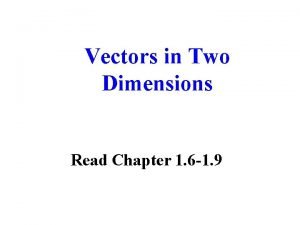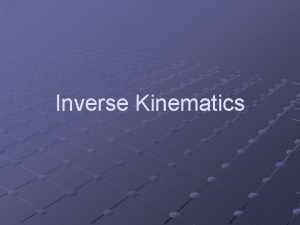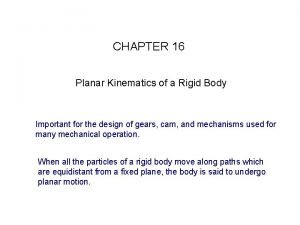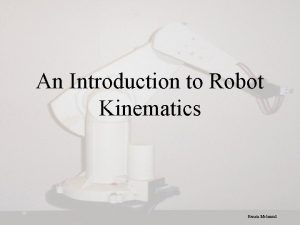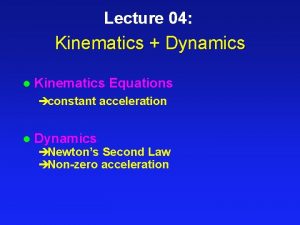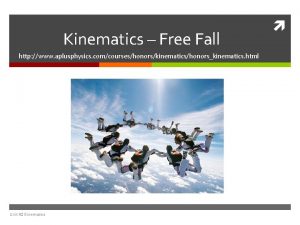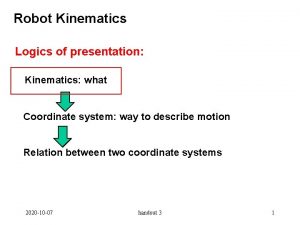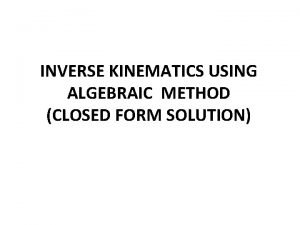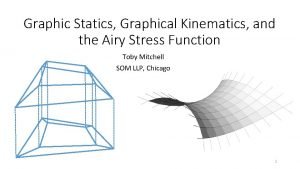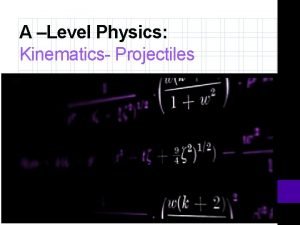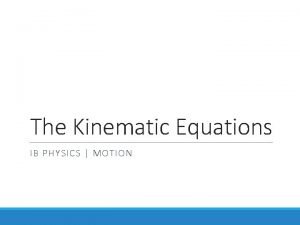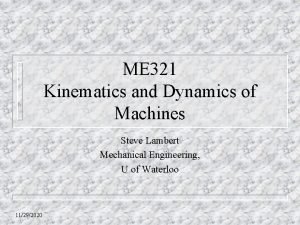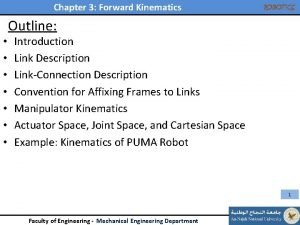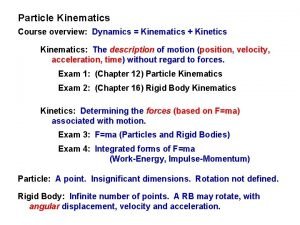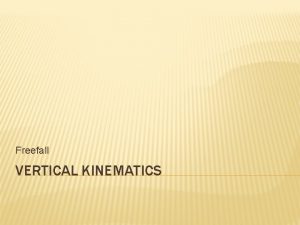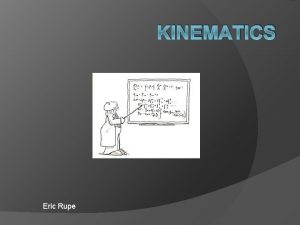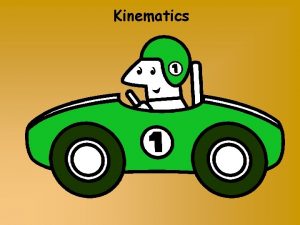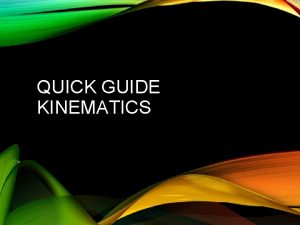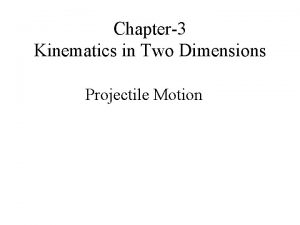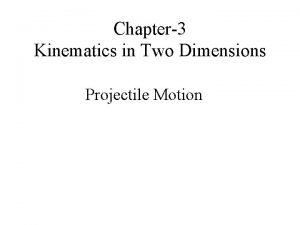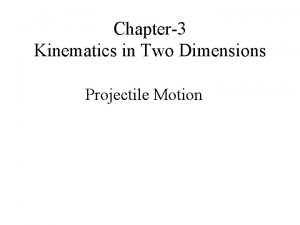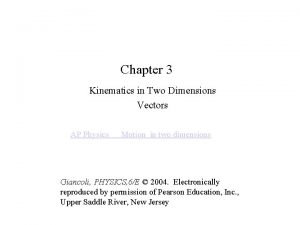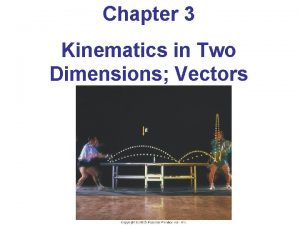Ch 3 Kinematics in 2 Dimensions Vectors Vectors
















- Slides: 16

Ch. 3, Kinematics in 2 Dimensions; Vectors

Vectors • General discussion. Vector A quantity with magnitude & direction. Scalar A quantity with magnitude only. • Here: We mainly deal with Displacement D & Velocity v Our discussion is valid for any vector! • The vector part of the chapter has a lot of math! It requires detailed knowledge of trigonometry. • Problem Solving A diagram or sketch is helpful & vital! I don’t see how it is possible to solve a vector problem without a diagram!

Coordinate Systems • Rectangular or Cartesian Coordinates – “Standard” coordinate axes. – Point in the plane is (x, y) – Note, if its convenient could reverse + & - - , + -, - +, + +, - Standard set of xy coordinate axes

Vector & Scalar Quantities Vector A quantity with magnitude & direction. Scalar A quantity with magnitude only. • Equality of two vectors 2 vectors, A & B. A = B means A & B have the same magnitude & direction.

Sect. 3 -2: Vector Addition, Graphical Method • Addition of scalars: “Normal” arithmetic! • Addition of vectors: Not so simple! • Vectors in the same direction: – Can also use simple arithmetic Example: Travel 8 km East on day 1, 6 km East on day 2. Displacement = 8 km + 6 km = 14 km East Example: Travel 8 km East on day 1, 6 km West on day 2. Displacement = 8 km - 6 km = 2 km East “Resultant” = Displacement

• Adding vectors in the same direction:

Graphical Method • For 2 vectors NOT along same line, adding is more complicated: Example: D 1 = 10 km East, D 2 = 5 km North. What is the resultant (final) displacement? • 2 methods of vector addition: – Graphical (2 methods of this also!) – Analytical (TRIGONOMETRY)

• 2 vectors NOT along same line: D 1 = 10 km E, D 2 = 5 km N. Resultant = DR = D 1 + D 2 = ? In this special case ONLY, D 1 is perpendicular to D 2. So, we can use the Pythagorean Theorem. = 11. 2 km Note! DR < D 1 + D 2 (scalar addition) Graphical Method: Measure. Find DR = 11. 2 km, θ = 27º N of E

• Example illustrates general rules (“tail-to-tip” method of graphical addition). Consider R = A + B 1. Draw A & B to scale. 2. Place tail of B at tip of A 3. Draw arrow from tail of A to tip of B This arrow is the resultant R (measure length & the angle it makes with the x-axis)

Order isn’t important! Adding the vectors in the opposite order gives the same result: In the example, DR = D 1 + D 2 = D 2 + D 1

Graphical Method • Adding (3 or more) vectors V = V 1 + V 2 + V 3 Even if the vectors are not at right angles, they can be added graphically by using the tail-to-tip method.

Graphical Method • Second graphical method of adding vectors (equivalent to the tail-to-tip method!) V = V 1 + V 2 1. Draw V 1 & V 2 to scale from common origin. 2. Construct parallelogram using V 1 & V 2 as 2 of the 4 sides. Resultant V = diagonal of parallelogram from common origin (measure length and the angle it makes with the x-axis)

Parallelogram Method Mathematically, we can move vectors around (preserving their magnitudes & directions) A common error!

Subtraction of Vectors • First, define the negative of a vector: - V vector with the same magnitude (size) as V but with opposite direction. Math: V + (- V) 0 Then add the negative vector. • For 2 vectors, V 1 & V 2: V 1 - V 2 V 1 + (-V 2)

Multiplication by a Scalar A vector V can be multiplied by a scalar c V' = c. V V' vector with magnitude c. V & same direction as V If c is negative, the resultant is in the opposite direction.

Example • A two part car trip. First, displacement A = 20 km due North. Then, displacement B = 35 km 60º West of North. Figure. Find (graphically) resultant displacement vector R (magnitude & direction). R=A+B Use ruler & protractor to find length of R, angle β. Length = 48. 2 km β = 38. 9º
 Aplusphysics kinematics-horizontal kinematics
Aplusphysics kinematics-horizontal kinematics Vectors in 2 dimensions
Vectors in 2 dimensions Forward kinematics
Forward kinematics Only lines or bodies undergo angular motion
Only lines or bodies undergo angular motion Kinematics
Kinematics Dynamics vs kinematics
Dynamics vs kinematics Aplusphysics: kinematics-free fall
Aplusphysics: kinematics-free fall Kinematics
Kinematics Planar kinematics of a rigid body
Planar kinematics of a rigid body Two dimensional motion and vectors
Two dimensional motion and vectors Closed form solutions
Closed form solutions Apertura numerica
Apertura numerica Kinematics
Kinematics A level physics kinematics
A level physics kinematics Ib physics data booklet
Ib physics data booklet Kinematics and dynamics of machines
Kinematics and dynamics of machines Forward kinematics
Forward kinematics

